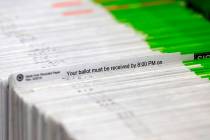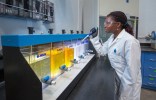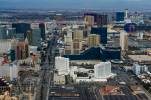Logic and environmental regulations
The term "mad as a hatter" arose from felt hat makers using nitrate of mercury in the process. After long-term exposure, the hatter often would develop a tendency to twitch or have difficulty talking and thinking -- construed as madness.
Thus, it is understandable we would be a bit concerned about the presence of mercury in dental fillings, vaccinations, fish, the water, the air, landfills.
Just this past week a group called Environment Nevada issued a report, using Environmental Protection Agency data, on how much mercury the state's coal-fired power plants emit. NV Energy's Reid Gardner Generating Station near Moapa emitted the most mercury of any Nevada power plant, 119 pounds in 2009. An NV Energy spokesman put that figure into perspective by noting Nevada mining operations release 5.2 million pounds of mercury.
Another way of looking at it is that the Reid Gardner plant released as much mercury as is contained in 13.5 million compact fluorescent light bulbs -- the purchase of which is encouraged by a rebate from NV Energy.
The rationale for those squiggly, dim light bulbs is that they actually reduce mercury release because they cut power use, a source of mercury release. To promote their use, Congress has banned the sale of most incandescent light bulbs after 2014.
But was a sharp enough pencil put to the cost-benefit ratio?
According to The Wall Street Journal, those far more expensive CFL bulbs -- three to 10 times as expensive as incandescent -- don't last as long as first claimed. Instead of a life of 9.4 years, as first estimated, actual experience finds a life closer to 6.3 years.
And will the rationale for using mercury-containing bulbs be obviated if the president achieves his goal of having 80 percent of America's electricity produced from nonpolluting renewable sources?
Besides, has anyone yet calculated the man-hours it takes to clean up a broken mercury-filled fluorescent bulb?
The short version of the EPA clean-up suggestions includes this advice: "Have people and pets leave the room. Air out the room for 5-10 minutes by opening a window or door to the outdoor environment. Shut off the central forced air heating/air-conditioning system, if you have one. Collect materials needed to clean up broken bulb. Be thorough in collecting broken glass and visible powder. Place cleanup materials in a sealable container. Promptly place all bulb debris and cleanup materials outdoors in a trash container or protected area until materials can be disposed of properly. Avoid leaving any bulb fragments or cleanup materials indoors. If practical, continue to air out the room where the bulb was broken and leave the heating/air conditioning system shut off for several hours."
In the three-page document on cleaning up broken CFLs, the EPA advises, "Check with your local or state government about disposal requirements in your area. Some states and communities require fluorescent bulbs (broken or unbroken) be taken to a local recycling center."
Should you drive to the recycling center in your electric car, which is charged by those mercury spewing power plants?
Does anyone think these things through before passing sweeping bans?























